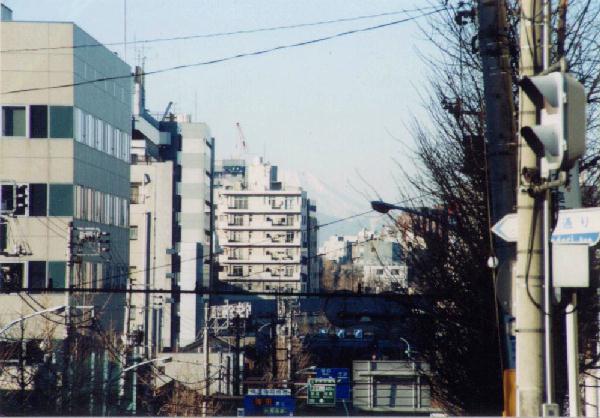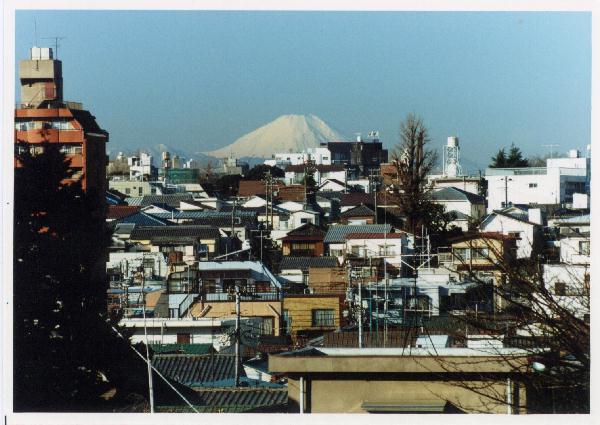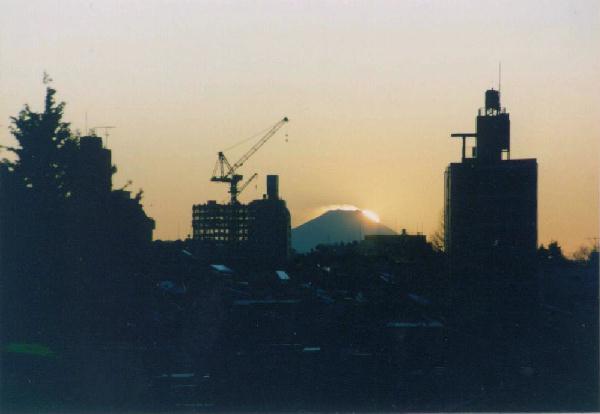
Mt. Fuji from Gokokuji Fujimizaka in Bunkyo Ward (Photo by Mr. Tetsuya Kawamoto)
Translated into English by Ms. Asami Masui
| A special procurement boom due to the Korean war, and the economic high growth brought Tokyo back to life in the postwar period. Meanwhile, the Tokyo Olympics in 1964 gave a start to the urban developement of Tokyo, which caused a big change in the scenery of Tokyo. |
| Owing to environmental pollution, the surroundings became worse and there was hardly a day that Mt. Fuji can be seen. But it was clear that one by one the scenery from Fujimizakas in Tokyo were becoming extinct. |

| Fujimizakas, located along and inside the JR Yamate line, some of which were named from the Edo era and the others were made in the Meiji era, may be listed as the following 16 slopes. |
In the table, Location is the present address, DownWards direction and Gradient are those of slope, Direction of Mt. Fuji is angle from west direction and towards south, and Width, Altitude of the top, Minimum altitude of the valley, and Difference of Top and bottom are all measured by meter.
| No. | name (another names) |
L | DW | G | W | DM | A | M | DT |
| 1 | Fujimizaka (Hanamizaka, Myouryujizaka) |
border of Nishinippori 3-cyoume 7 and 8, Arakawa ward |
From ENE to WSW | 7 | 3.2 | 23 | 21 | 6 | 15 |
| 2 | Fujimizaka | border of Hongou 2-cyoume 2 and 3, Bunkyou ward |
From North to South | 3.5 | 6.4 | 21.5 | 22 | 4 | 18 |
| 3 | Fujimizaka (Gotenzaka, Goten-omotezaka, Oosaka) |
border of Hakusan 2-cyoume and Koishikawa Botanical
Gardens, Bunkyou ward |
From NE to SW | 4.5 | 5.4 | 23 | 21 | 8 | 13 |
| 4 | Fujizaka (Kamurozaka) |
border of Kobinata 4-cyoume 3 and 4, Bunkyou ward |
from ENE to WSW | 10.8 | 3.9 | 23 | 26 | 20 | 6 |
| 5 | Fujizaka (Hudouzaka) |
border of Ohtsuka 2-cyoume and 5-cyoume (Shinobazu
street), Bunkyou ward |
from ENE to WSW | 4.3 | 20 | 23.5 | 27 | 14 | 13 |
| 6 | Fujimizaka (Hinashizaka, Azumazaka) |
border of Takada 1-cyoume 23 in Toshima ward and Mejirodai 1-cyoume in Bunkyou ward | from NNE to SSW | 13 | 4.3 | 23.5 | 29 | 10 | 19 |
| 7 | Fujimizaka | border of Kanda Ogawacyou 3-cyoume 10 and 14, Chiyoda ward |
from ENE to WSW | 2 | 7.7 | 21.5 | 10 | 2 | 8 |
| 8 | Fujimizaka | border of Kudan Kita 3-cyoume 1 and Fujimi 2-cyoume 15,
Chyoda ward |
from ENE to WSW | 3 | 5.6 | 21.5 | 26 | 13 | 13 |
| 9 | Fujimizaka (Mizusaka) |
border of Nagatacyo 2cyoume and Kioicyou, Chiyoda ward |
from East to West | 3.5 | 38 | 20.5 | 29 | 10 | 19 |
| 10 | Fujimizaka (Miyamasuzaka) |
border of Shibuya 1-cyoume and 2-cyoume, Shibuya ward |
from East to West | 2.5 | 21 | 20 | 34 | 15 | 19 |
| 11 | Fujimizaka (Nanbuzaka, Nankakuzaka) |
border of Higashi 2-cyoume and 3-cyoume, Shibuya ward |
from ENE to WSW | 3.8 | 8.3 | 19.5 | 27 | 14 | 13 |
| 12 | Fujimizaka (Kougaizaka, Dai-yokocyouzaka) |
border of Nishiazabu 3-cyoume 16 and 17, Minato ward |
from East to West | 3.8 | 5.5 | 19.5 | 32 | 14 | 18 |
| 13 | Fujimizaka (Aokizaka) |
border of Minamiazabu 4-cyoume 10 and 11, Minato ward |
from EN to WS | 8.8 | 3.4 | 19 | 24 | 10 | 14 |
| 14 | Shin-fujimizaka | border of Minamiazabu 4-cyoume 5 and 10, Minato ward |
from East to West | 12 | 5.7 | 19 | 24 | 10 | 14 |
| 15 | Fujimizaka | Shiba park 4-cyoume 3 (west of Tokyo tower), Minato ward |
from North to South | 1.2 | 19.5 | 21 | 5 | 16 | |
| 16 | Fujimizaka | border of Meguro 1-cyoume 1 and 2, Meguro ward |
from ENE to WSW | 5.7 | 6 | 18.5 | 29 | 6 | 23 |
Table created by Society for Prospect Research of Fujimizaka
| Subway Chiyoda line has opened for traffic in 1969, and Nishinippori station was placed, so the surroundings of Suwadai was rapidly developed. |
| Many high buildings appeared in front of the station from 1983, the time of the so-called bubble economy. From the present Suwa shrine, due to the Yamanote-line which runs under the hill, the horizontal view is still available, but unfortunately, the front view is blocked by the buildings standing in a row nearby, on either side of the track. |
| Shinobazu street also became a target of developement because the district along it gained a potential from the subway Chiyoda line which runs through the underground of the street, so the place became covered with tall buildings, as well. Since that time, the view of Mt.Fuji from Fujimizaka was becoming at stake. |
| Nippori Fujimizaka was featured in a TV program on NHK in 1986, but there were no sights of buildings in the scenery at that time. |

From Nippori Fujimizaka in about 1990 (Photo by Mr. Tadashi Ishikawa)
| The increase of buildings in Shinobazu street started from Nezu area which was near the center of the city, and the wave of developement a little later reached the surroundings of Sendagi, which is located on the foot of Fujimizaka. In relation to the road in front, all the high rises are actually standing in one row along Shinobazu street, and many small shops, residential areas and row houses remain behind the street even today. Most of the tall buildings that suddenly hover over the roof tops are offices or apartment houses, and many of which remain standing without much communication with the neighborhood. |
| Within these insecure circumstances, Nippori Fujimizaka was chosen for the "May this scenery last forever" award, at the "Tokyo City View Contest" in 1996. |
| Introduction at 1996 Contest | |||
|
| ||

The contest 1996 awarded photo | |||
| The 16 Fujimizakas which has been inherited from Edo to Tokyo, lost all of it's scenery, leaving only a partial view from Gokokuji Fujimizaka and the scenery from Nippori Fujimizaka. |
| From Nippori Fujimizaka, you can still see the sight of Mt. Fuji which has miraculously been preserved till this day in the 21st century. This scenery exists as a scenic heritage that we must hand down to the next generation. |
| Japanese Home Page | |
| English page |